For the last few years, I've been using Getting Things Done (GTD) as the main way to organize most aspects of my life. Many of you will be familiar with GTD, but for those who are not: GTD is a system to make you more productive. David Allen introduced it to the world in 2001. It relies on these five steps:
- Capture: gather everything that's on your mind in a capture bucket.
- Clarify: determine whether something is actionable or not.
- Organize: place it in the right place (e.g. project folder, calendar).
- Reflect: review your folders and lists frequently.
- Engage: do what's actionable based on context, time, energy, priority.
That's GTD in a nutshell. It's a wonderful system that does what it says: it gets things done. However, certain things can't "get done", and that's a problem. Because GTD is so comprehensive, it's tempting to think GTD can help you with everything. But that's not true at all.
GTD is a very poor system when it comes to retaining knowledge. This is something I've personally experienced. I've had a reference folder in Evernote for years. It was nicely categorized by topic and filled with notes that had copied snippets taken out of books and articles.
Did I ever browse those notes? No, I didn't. Did they help me remember what I'd read? No, they didn't. I did nothing useful with those notes.
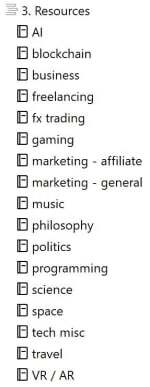
A few months ago, I decided this wasn't okay anymore. After all, I read plenty of non-fiction books and tons of articles. But what's the point if I don't use that input to generate my own insights?
If I didn't take immediate action to change my behavior after I'd read something insightful (and most of the time, I didn't), I'd forget what I'd read. I might as well not have read the book or article.
All this reading would give me the feeling that I was building knowledge, but in actuality I was treading water. So I decided I needed a better way to retain knowledge.
Niklas Luhmann and His Zettelkasten
In order to properly explain what a "Zettelkasten" is, I need to tell you about Niklas Luhmann. Unless you're from Eastern Europe (or Japan, weirdly), you've probably not heard of him, but Luhmann was one of the most important social theorists of the 20th century.
Over the course of thirty years, Luhmann produced a theory of society, where each chapter in his theory was a sophisticated and complex book. The topics of each chapter varied wildly. He wrote about love, economics, trust, risk, and more. All in all, he published 58 books and hundreds of articles until his death in 1998. Many of these books are considered classics in their respective fields.
When people asked Luhmann how he was so prolific over such a wide variety of topics, he'd attribute it almost entirely to one thing: his Zettelkasten. Tens of thousands of notes in wooden boxes, organically linked to one another through a simple, fixed numbering system.
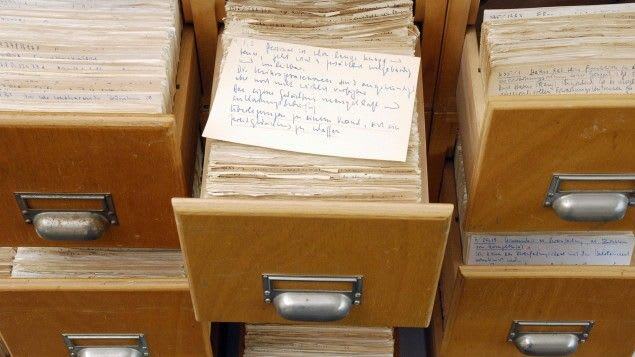
Here's what Luhmann did: whenever he read something interesting, he'd create a note (a Zettel) about it. The note would be entirely self-contained. It would concisely explain or state the smallest piece of complete information and it would refer back to the original source.
Luhmann would not simply copy the information from its original source. Instead, he'd write each Zettel in his own words. Then he would think about how this new information linked to the other notes he already had in his Zettelkasten. Each note had a fixed number. If a certain note would link to note 402, he'd number it 403. But if note 403 already existed, he'd number it 402/a.
Through a system of letters and numbers, you can almost infinitely branch out your trains of thoughts. A note that's numbered 319/d/3/a/7 would follow up a note numbered 319/d/3/a/6.
Here's an example: Imagine you're researching cancer. Your research will inevitably branch off in types of cancer. You might have some information on brain cancer and some on skin cancer. You might notice that certain ways of treatment work better on brain cancer than on skin cancer, and you'd make a Zettel that would link both to your research on skin cancer and on brain cancer.
Luhmann's simple way of linking notes can sustain complex and detailed trains of thoughts. The more notes that are interlinked, the more the Zettelkasten becomes a system to retain knowledge and generate insight for your future self.
Zettelkasten in the Digital Age
As remote developers who like travel, it's unlikely we'll want to buy and carry along wooden boxes filled with thousands of notes. But it's 2019. There are plenty of digital tools that allow you to build out your own Zettelkasten system.
A disclaimer first: the tool isn't going to make you brilliant. Shakespeare wasn't Shakespeare because of the type of paper he wrote on. The tool is an enabler, but there's no point searching for the perfect one, because it doesn't exist.
All you need is something with a markdown editor that allows you to link notes, add tags, and has a good search system. There are a few specific Zettelkasten tools available, most of which you can find listed here, but I'm most familiar with Evernote and so that's what I use.
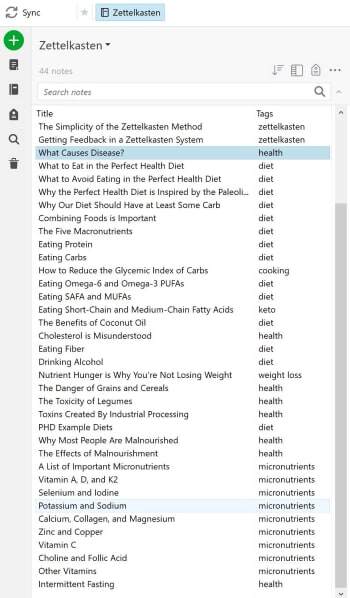
My Zettelkasten is a single Evernote notebook where the notes are sorted by date of creation. There's no need to number or organize notes, because you can use a note's internal link to link notes together. You can also organize notes through tags and you can use Evernote's search to look for the notes you want.
I recently summarized Perfect Health Diet, a book by Paul & Shou-Ching Jaminet that proposes a way of eating for great health. It's a science-heavy book, and I took 34 notes to summarize it entirely. Here's how a single note looks like:
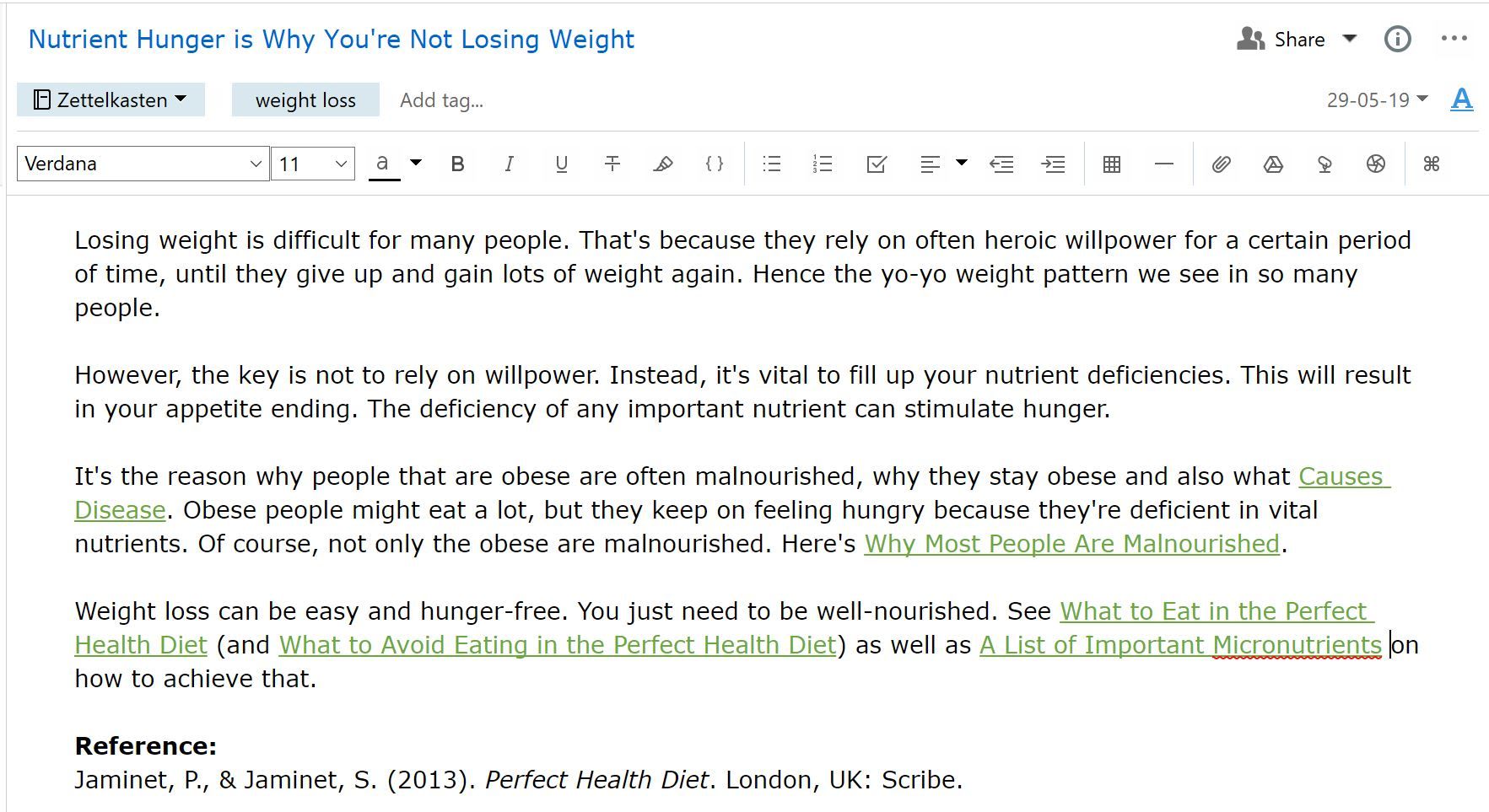
Each note has the same structure. It has a tag, explains something concisely in my own words, and it refers to the original source. Each note is linked as well, to whichever other note I believe is relevant. All this is important, as you want your notes to be found.
If I now read something else that's relevant to the above note on nutrient hunger, I could either add that information to the existing note or create a new note altogether and link it accordingly, as well as reference it appropriately.
From the above note on nutrient hunger, if I click on "A List of Important Micronutrients", this note would show up:
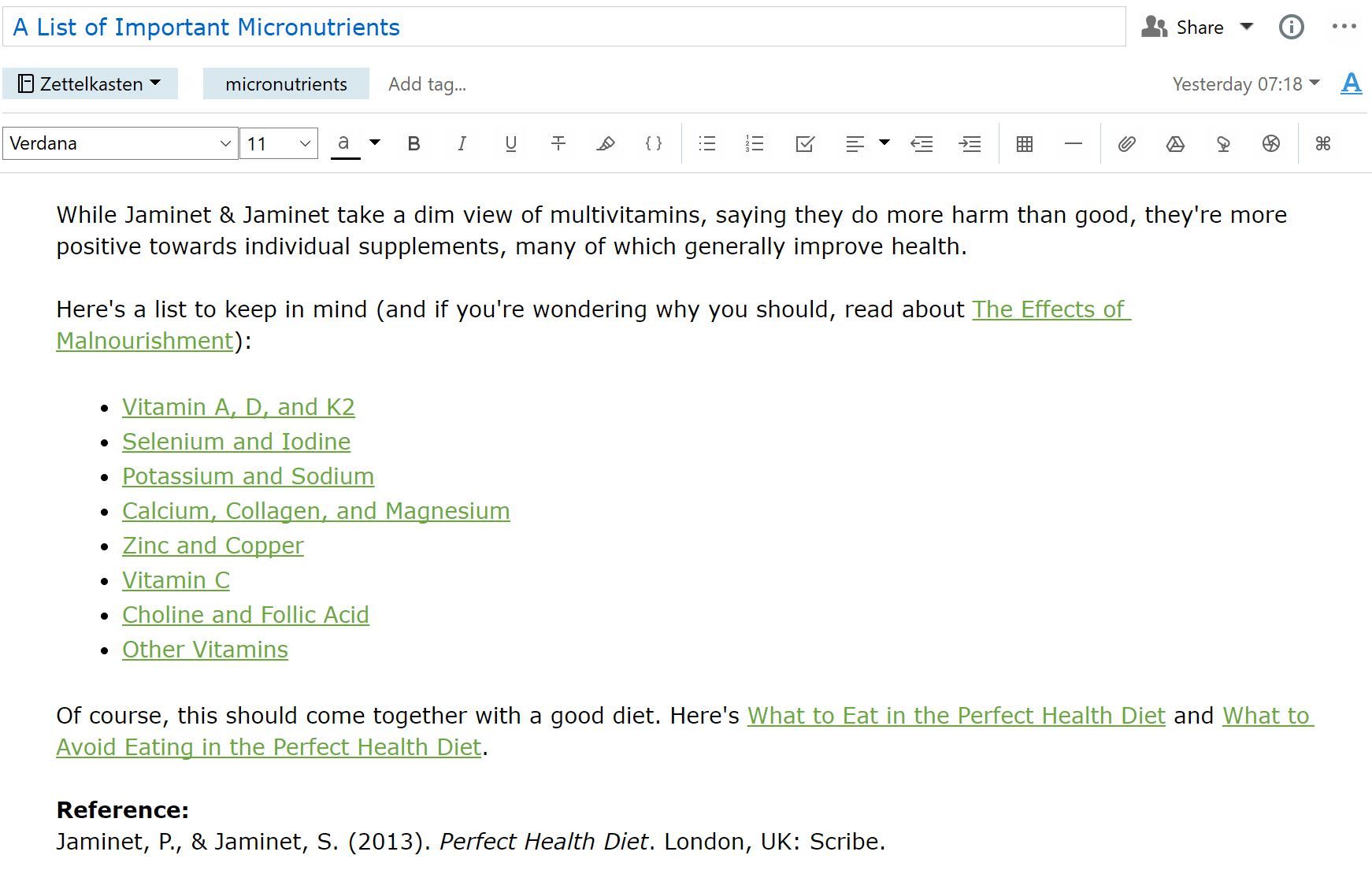
As you can see, this note is a bit more of an index note than it is the source of a snippet of information. That's because it's a new topic. We've moved from talking about weight loss (which requires you to eat the right nutrients) to talking about micronutrients. In the book, Jaminet & Jaminet talk about many different micronutrients, so I thought it'd be appropriate to create an index note that would summarize them all.
What's wonderful about this way of working is that it's motivating. It doesn't require willpower to keep going. Instead, it has a forward momentum that makes me want to work on it.
For example, Jaminet & Jaminet don't talk all that much about alcohol, and so my note on it is limited. As such, I'm tempted to read more about the pros and (more likely) cons of alcohol, so my understanding in that area can become more comprehensive.
Additionally, because you write each note in your own words, you retain the knowledge better and it also becomes easier to write about a topic you've researched in your Zettelkasten, as you already have material in your own words.
A New Way of Thinking
Zettelkasten lends itself particularly well for academics, researchers, and students. But aren't we all students? When we're learning a new programming framework, wouldn't it help to write down our insights in a Zettelkasten system? When we're reading about AMD's and Intel's new products at Computex, wouldn't it be helpful to place that information in the web of notes you've created on computer chips?
The Zettelkasten way of working compounds. The more notes, the better it becomes. It's your external, second brain that helps you make connections and retain knowledge much better than any other system I've used before.
If you want to learn more about Zettelkasten, I highly recommend the book How to Take Smart Notes by Sonke Ahrens, as well as all the blog posts on https://zettelkasten.de/, the main hub for anything Zettelkasten.
What about you? How do you capture and retain knowledge?



